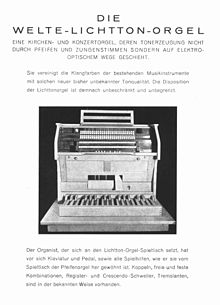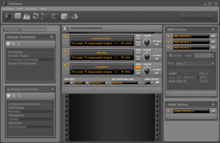Sampler (sound generator)

A sampler is an electronic musical instrument , usually controllable via MIDI , which can record sounds of any kind, save them in the form of samples and play them back on command at different pitches . Samplers can now be played polyphonically and multitimbrally .
function
A sampler is able to play recorded tones, the so-called samples, without delay and also at a different pitch than when recording. For this purpose, real sounds (via microphone or other sound sources) are recorded digitally. The audio material is scanned and saved as a short audio track, in other words as a sample . During playback, the sampler can speed up or slow down the playback, which changes the pitch of the sound. There are also methods with which the pitch of the sample can be changed without speeding up or slowing down its timing (see also changing the pitch ).
The storage of analog signals is done by sampling the amplitude at regular intervals and digitizing using an analog-digital converter . The frequency of these individual measurements is called the sampling rate . The fineness of the scanning is called resolution; it depends on the number of bits with which a value is quantized and stored. Sample rates of 44.1 kHz to 192 kHz and 16 to 32 bit quantization resolution are common in modern samplers. In some cases, however, technically outdated samplers with 8 or 12 bit resolution enjoy a certain popularity among musicians due to the sound that is perceived as "dirty" and "warmer".
The finished sample has to be saved, which is now usually done on a hard drive or flash memory . Early samplers used floppy disks for this . For playback, the sound had to be in the main memory ( RAM ) and therefore usually had to be loaded first. Today's systems can also play directly from Flash. In early models, the maximum length of the samples used is severely limited because the main memory was very expensive at the time. In order to be able to influence the sounds during playback (for example to change the pitch), a sampler also needs a powerful processor that can handle the necessary calculations.
Nowadays personal computers are so powerful that they are also able to take over the tasks of a sampler with the appropriate software . The main processor of the computer uses appropriate software samplers to perform the tasks that are usually performed by digital signal processors (DSP) in hardware samplers . There are also combinations of software and hardware, with DSP cards or special powerful sound cards expanding the PC.
Since a sample because of the limited space can not be of any length, the clay material while playing mostly after a certain time (after is transient , which is especially important for the sound characteristics) in an endless loop ( Loop repeated). Different instruments are created and mixed at the same time from several waveforms and sections, see Wavetable Synthesis . Since the overall sound of natural instruments (e.g. piano) consists of more than the sum of the individual tones, sampling is often supplemented by other sound generation methods (e.g. physical modeling to simulate housing resonances, etc.). In addition, almost all devices have a wide range of filters , built-in effects and other sound shaping methods, which makes them full-fledged synthesizers .
Recording and cutting samples is a complex and time-consuming job, which is why many musicians buy ready-made sample libraries on CD or DVD. There are also hardware samplers that can only play but not record, they are also known as romplers (from ROM , read-only memory). Nowadays, instrumental samples designed to reproduce all the intricacies of a natural instrument can easily span several gigabytes .
precursor
The precursors of the sampler are the following instruments, which already use techniques that later defined the sound generator:
- In the Technical Museum in Vienna there is a “Superpiano” from 1928 with photoelectric sound generation by rotating, patterned, perforated metal disks; In 1929 they were replaced by film disks on which speech and music could be exposed using optical sound technology. It has a punch card control for creating sequences.
- The optical sound organ developed by Edwin Welte in the 1930s also uses discs made of photographic material as audio storage.
- The basic idea of playing back previously recorded natural tones at the touch of a button can be found in the Mellotron , a keyboard instrument that can play a single, approx. Eight second long tape per key with a sound recorded by the manufacturer; the sounds cannot be looped.
- The idea of changing the pitch in a musically meaningful way during playback can be found in a tape recorder in the studio of Pierre Schaeffer and Pierre Henry that is not mentioned by name , which has been modified so that it can play a tape at twelve different speeds corresponding to the twelve semitones of the western ( diatonic ) tone system.
The sampler became technically possible when the processor power was sufficient to play back a saved sample in real time at a different pitch. The first commercially available sampler was the Fairlight CMI in 1979 , which was then available for the equivalent of around US $ 1 million today; this device differs from later samplers etc. a. by playing the same audio sample in full with a different sampling frequency to change the pitch. Later samplers, on the other hand, maintain a constant sampling frequency for playback and, depending on the desired pitch, change the step size with which they select the next sample to be output from the memory contents. In 1985, the Ensoniq Mirage was the first mass sampler with multi-sampling options for less than 6,000 DM . The S612 from Akai was the first reasonably affordable sampler in a 19-inch housing design and was therefore also known as the “people's sampler”. It was the first sampler ever made in Japan.
Software sampler

A software sampler is a computer program that emulates a sampler, i.e. it can play any digitally recorded sound. It can be regarded as the successor to the classic hardware models.
The change in pitch of a stored digital sample can be implemented by corresponding sampling rate conversion (resampling) to the fixed sampling rate of the sound hardware output channel. With resampling, however, the sampling theorem can be violated, especially when increasing the pitch , and disruptive aliasing effects occur. There are many algorithmic approaches with different computational effort to reduce these effects; the quality that is achieved by samplers is one of the most important quality features.
Most of the soft samplers in use today have a modular structure and are sometimes combined with software synthesizers . Well-known programs are e.g. B. EXS24 (only Apple Logic), Gigastudio, Halion, LinuxSampler or Kontakt. These software samplers are designed as plug-ins for sequencer programs such as Cubase , Sonar or Logic . There is an independent, host-independent sampler in the MusikLaborSynth .
The samples are not completely loaded into the RAM, only the first few moments. If necessary, the rest of the sample is then reloaded from the hard disk for playback. This also shortens preparatory loading times. The Gigasampler / Gigastudio from Tascam is the first device to be equipped with this technology.
History of the software sampler
In the early days of software samplers, the problem was that the upward and downward conversion of audio files required a lot of computing time and storage space. Until the mid-1990s, only monophonic (unanimous) software samplers could therefore run on commercially available PCs , which used certain tricks to shorten computing times. Software samplers have also been real-time capable on PCs since around 1997 and have replaced hardware-based samplers in almost all areas. Advantages through lower costs, larger display (monitor of the computer), more RAM, faster processing, integration into other software have led to this.
The tracker sequencers developed on home computers in the 1980s and 90s can also be counted among the software samplers (or as an extension of them), since real-time resampling is a necessary capability of the tracker concept. Already in the 1980s, trackers were able to perform real-time resampling on the Amiga 4 (with hardware support from the Paula chip ) and in the early 1990s as a pure software solution on the PC. For this purpose, highly optimized, hardware-related assembler code was written to enable this as a pure software solution. An early example is the InertiaPlayer from 1993. A current tracker with very good sampler properties is the Renoise tracker, for example .
"Jingle machine"
A special type of sampler is the “cart machine”, also known as the “ jingle machine”. Here, short melody sequences or tones that act as a recognition signal ( sound logo , "audible trademark") are called up by pressing a button. This is often used when designing radio programs. As with the samplers, hardware and software solutions are also used here.
See also
literature
- Roland Enders: The home recording manual. The way to optimal recordings. 3rd, revised edition, revised by Andreas Schulz. Carstensen, Munich 2003, ISBN 3-910098-25-8 .
- Thomas Görne: Sound engineering. Fachbuchverlag Leipzig in Carl Hanser Verlag, Munich et al. 2006, ISBN 3-446-40198-9 .
Web links
- LinuxSampler - open source sampler with disk streaming for Windows, Linux Mac OS X (engl.)
- Sample Player - HTML-5-Sample-Player (runs under Firefox from version 3.5, uses the HTML-5 <audio> element)
- ShortCircuit - very extensive freeware sampler in VST format
Individual evidence
- ↑ a b Simon V .: Sampler anti-aliasing and pitch-shifting comparison ( English ) www.simonv.com. May 8, 2001. Retrieved February 5, 2011.
- ↑ a b Matthias Ziegs: Resampling quality in comparison . MAZ sound tools. 2005. Archived from the original on March 8, 2011. Retrieved February 5, 2011.
- ↑ Inertiaplayer 1.0b ( page no longer available , search in web archives ) Info: The link was automatically marked as defective. Please check the link according to the instructions and then remove this notice. 100% Assembler […] up to 32 channels […] This player was released 24 Dec '93, while you where singing in church :-) (iplay.doc, English)


